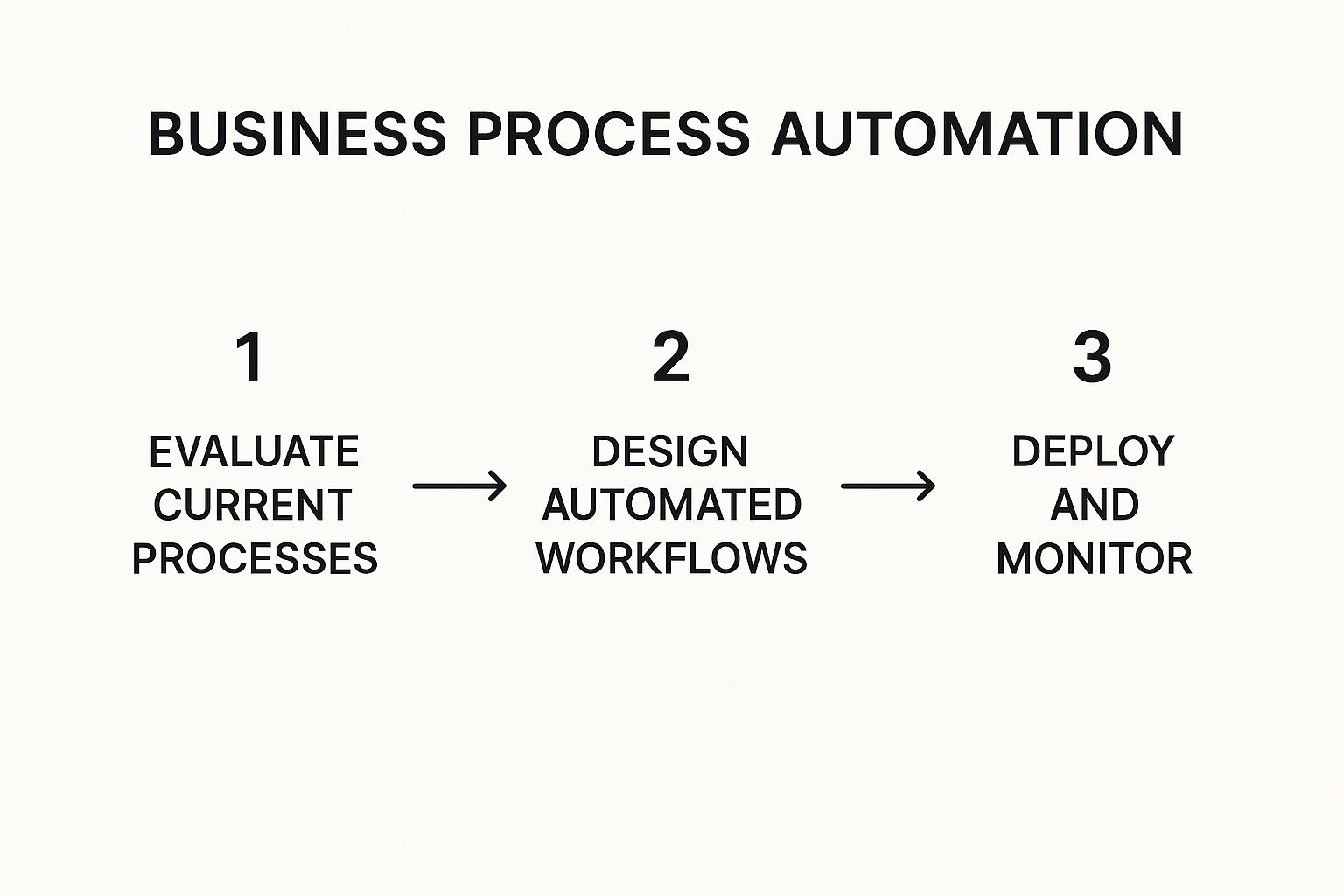As leaders in business transformation, we've guided countless companies through the strategic shift to Business Process Automation (BPA). On the surface, it may sound like another piece of corporate jargon, but at its heart, it’s a foundational strategy: using technology to orchestrate the repetitive, rule-based tasks that constrain your business's potential.
It’s about evolving beyond operations that depend on manual data entry, paper-pushing, or chasing approvals. Instead, you design a system where work and information flow automatically, guided by intelligent software and clear business rules.
So, What Is Business Process Automation, Really?
To truly grasp its power, think of your company’s day-to-day operations as navigating a congested city centre during rush hour. You face endless traffic lights, unexpected roadworks, and constant stop-and-go traffic. That's the reality of manual processes—work gets stuck awaiting an email reply, data entry creates backlogs, and critical information is siloed in someone's spreadsheet.
Business Process Automation is the strategic equivalent of building a dedicated motorway for your business. It creates a smooth, fast, and direct route for tasks and data to move from A to B without interruption. This isn't just about moving faster; it's a fundamental redesign of how work gets done to build a more efficient, resilient, and scalable organisation.
From our extensive experience, business process automation isn't about replacing people. It’s about elevating their contributions from tedious, low-value work to high-impact strategic thinking and problem-solving. It frees your most valuable asset—your team—to focus on what truly drives growth.
The Core Principle
At its most basic, BPA identifies the predictable and repetitive steps within a workflow and leverages technology to execute them. This could range from automatically routing an invoice for approval to initiating the entire onboarding process for a new hire.
However, this is far more than just automating isolated tasks. A true BPA strategy examines the entire process chain to unlock holistic improvements. Consider the potential across different departments:
- Finance: Automating the entire accounts payable cycle, from invoice ingestion and data extraction to approval routing and payment processing.
- Human Resources: Systemising the employee journey, which can include automatically dispatching contracts, raising IT setup requests, and enrolling new hires in essential training modules.
- Customer Service: Implementing intelligent ticketing systems that analyse incoming customer queries and instantly route them to the most qualified agent based on keywords or issue type.
- Operations: Automating inventory control by triggering reorder alerts the moment stock levels fall below a predetermined threshold.
To illustrate the transformative nature of this shift, let's compare the traditional way of working with the new, automated standard.
Manual vs Automated Operations At a Glance
This table breaks down the contrast between managing key business activities manually versus using automation, highlighting the tangible benefits that stem from this strategic evolution.
As you can see, automation doesn't just accelerate operations—it introduces a level of precision and reliability that manual processes simply cannot achieve.
A Strategy Gaining Momentum
The rapid adoption of BPA is no surprise when you analyse its impact. The global market for business process automation is projected to grow from $14.87 billion in 2024 to nearly $29.6 billion by 2029. This is not a fleeting trend; it is a strategic imperative driven by the concrete results businesses are seeing across every industry.
Crucially, this is no longer the exclusive domain of large corporations. The tools and platforms available today are perfectly suited for ambitious medium-sized businesses. To see how this manifests in practice, we recommend exploring these real-world business process automation examples to see how other companies are leveraging it to fuel genuine growth.
Ultimately, the goal is to build a smarter, more agile operational engine for your entire business.
The Strategic Gains of Automating Your Business

When business process automation is discussed, the conversation often begins and ends with cost reduction. While that is certainly an outcome, the true strategic advantages run much deeper, fortifying your entire organisation. It isn’t just about spending less; it's about what you can achieve when you liberate your most valuable resources.
By delegating routine, rules-based tasks to technology, your leadership team is no longer consumed by fighting operational fires. Instead, they can redirect that energy towards what truly matters: market innovation, competitive strategy, and long-term growth. This is a fundamental pivot for any ambitious business.
Consider the implications: instead of managers spending their days chasing approvals or verifying data, they can focus on mentoring their teams, exploring new revenue streams, or perfecting the customer experience. This is where your competitive advantage is truly forged—not in the speed of data entry, but in the quality of the decisions that follow.
Sharpening Decision-Making with Accurate Data
One of the most significant and immediate benefits of automation is the quantum leap in data accuracy. Manual processes are an inherent breeding ground for human error. A mistyped number, a misplaced decimal point, or a file saved in the wrong location—these seemingly small slips can easily snowball into major problems, leading to flawed financial forecasts, incorrect stock levels, or even compliance breaches.
Automation systematically eliminates this risk. When systems are configured to capture, process, and store information according to predefined rules, the data becomes consistently reliable. This clean, trustworthy data is the bedrock of sharp, confident decision-making.
By eliminating the persistent noise of manual errors, automation allows you to trust your data implicitly. This empowers leaders to make bolder strategic moves, secure in the knowledge that their decisions are built on a solid foundation of accurate, real-time information.
This newfound data integrity creates a positive ripple effect across the entire business. Take your finance team, for instance. With an automated invoicing system, they're not just accelerating cash flow; they're gaining precise data on payment cycles and customer behaviour. This allows them to transition from transactional processing to high-level financial analysis that genuinely guides business strategy.
Boosting Team Morale and Engagement
Perhaps the most underrated advantage of business process automation is its profound impact on team morale. No one is inspired by monotonous, repetitive work. Tasks like copy-pasting data between spreadsheets, manually chasing invoices, or processing identical forms day after day are mentally draining and deeply unfulfilling.
Automating these activities provides immense relief. It liberates your team from drudgery and allows them to engage in the more creative, challenging, and valuable work that requires a human touch—such as problem-solving, building customer relationships, and strategic thinking. This shift doesn't just make their roles more interesting; it sends a clear message that you value their intellect over their ability to perform robotic tasks. As a leader, navigating this transition is critical, which is why we’ve developed a leader's guide to automation and AI to support you.
This transformation is evident in departments like Human Resources. Implementing automation here can be a game-changer. For example, by using tools for automated candidate screening, HR professionals can stop wasting time sifting through unqualified applications. Instead, they can invest that valuable time in engaging with top-tier talent, nurturing company culture, and developing employee growth programs.
Unlocking Organisational Agility
Finally, automation provides a critical strategic edge: organisational agility. In today's dynamic market, the ability to adapt is paramount. Manual processes are often rigid and slow to change, creating operational bottlenecks precisely when the business needs to pivot.
Automated workflows, by contrast, are designed for flexibility. They can be quickly modified, scaled up or down, or reconfigured to meet new demands. Whether you're handling a sudden surge in customer orders or adapting to new regulations, automation enables your business to respond in days or even hours, not weeks or months. This confers a clear and distinct advantage over slower-moving competitors.
Where to Start Your Automation Journey

Deciding where to initiate your business process automation journey can feel overwhelming. Our advice, based on years of experience, is to start smart, not big. Attempting to overhaul everything at once is a recipe for failure. The optimal approach is to pinpoint specific areas where automation will deliver immediate, tangible value. This builds momentum, demonstrates a clear return on investment, and paves the way for wider adoption.
Over the years, we've observed which functions consistently provide UK businesses with the most significant initial wins. These are the departments often mired in repetitive, rules-based tasks—the perfect candidates for a well-executed automation project.
Let's explore the prime starting points within your organisation.
High-Impact Finance Automation
Your finance department is almost invariably the most logical place to begin. It's a domain saturated with high-volume, repetitive tasks where accuracy is paramount, and even minor delays can directly impact cash flow. Automating these processes isn't just about reducing costs; it’s about building a more robust financial backbone for the entire company.
The most common and effective starting points in finance include:
- Accounts Payable (AP): Automating invoice processing is a classic, guaranteed win. Instead of an employee manually keying in data from supplier invoices, a system can extract the relevant information, match it against purchase orders, and route it for digital approval—all without human intervention.
- Accounts Receivable (AR): Conversely, you can automate the generation and dispatch of customer invoices, send automated payment reminders, and track incoming payments. This dramatically accelerates your cash conversion cycle and reduces the manual effort spent pursuing late payments.
These processes are ideal because they are governed by clear rules, occur with high frequency, and have a direct, measurable impact on your bottom line.
Streamlining Human Resources
Your HR department is another excellent candidate for automation, particularly for processes involving the management of employee data and coordination with other departments. Manual HR workflows are not only slow but also prone to errors that can lead to compliance issues and negatively impact employee morale.
Consider these high-value opportunities:
- Employee Onboarding: A new hire’s initial experience is crucial. Automation can orchestrate the entire onboarding process, from distributing contracts and policy documents to automatically triggering IT requests for laptops and system access.
- Payroll Processing: By integrating timesheets and HR data, payroll automation ensures everyone is paid accurately and on time, every time. It eliminates the risk of manual calculation errors and simplifies compliance with tax regulations.
By 2025, it's estimated that 69% of all managerial tasks will be fully automated, freeing up leadership to concentrate on strategy. This shift is accelerating, with 80% of UK businesses now fast-tracking their automation plans. Despite this, finance departments are lagging, with only 13% fully automated, indicating a significant opportunity for growth. You can learn more from these UK business automation trends and statistics.
Enhancing Customer Service Operations
In today's competitive landscape, a swift and efficient customer service operation is non-negotiable. Automation can empower your team to handle queries faster and more effectively, freeing them to address the complex issues that genuinely require a human touch.
Key areas for consideration include:
- Intelligent Ticket Routing: Automation software can analyse incoming support requests (from emails or web forms) and automatically assign them to the appropriate person or department based on keywords, customer history, or issue type.
- Automated Responses and Support Bots: For common, repetitive questions, a support bot can provide instant answers 24/7. This resolves simple queries immediately and reduces the volume of tickets your support team must handle manually.
Automating these customer-facing processes not only enhances your team's efficiency but also directly boosts customer satisfaction through faster response times. By beginning your business process automation journey in these key areas—Finance, HR, and Customer Service—you can secure quick wins that build a powerful business case for expanding automation across the rest of your organisation.
Your Strategic Roadmap for Bringing Automation to Life
Successful automation is not merely about acquiring the latest software; it's about executing a well-defined plan. This represents a significant organisational change, one that demands strategic foresight and careful implementation. Having guided countless businesses through this exact journey, we have distilled our experience into a clear, step-by-step roadmap that ensures you achieve desired outcomes while sidestepping common pitfalls.
View this less as a technical checklist and more as a strategic guide. It’s designed to position your automation projects for long-term success, secure team buy-in, and deliver a tangible return on investment from the outset.
Phase 1: Pinpoint and Prioritise Your Processes
First, set technology aside. You must begin by looking inward at your current business operations. The goal is to identify which tasks are prime candidates for automation. An effective method for this is to evaluate them against two simple criteria: business impact and feasibility of automation.
Start by mapping a few of your existing workflows. Trace a single process from start to finish, noting every manual step, every handoff between individuals, and every point where delays or errors commonly occur.
Once you have a list of potential processes, it's time to score them. High-impact processes are those that, if automated, would yield significant benefits—such as substantial cost savings, risk mitigation, or improved customer satisfaction. High-feasibility processes are typically repetitive, follow clear rules, and utilise structured digital data. Your ideal starting point is a process that scores high on both metrics.
This flow chart illustrates the key stages of a business process automation project, from initial discovery through to long-term maintenance and optimisation.

As you can see, a successful project moves logically from understanding what to automate, to designing how to automate it, before you finally deploy and improve.
Phase 2: Design, Test, and Select Your Tools
With your top-priority process identified, you can begin designing its automated future state. This involves mapping out precisely how the process will function when technology performs the heavy lifting. It is crucial to involve the people who currently execute the process; their practical insights are invaluable for designing a system that works in the real world, not just on paper.
Before contemplating a company-wide rollout, you must conduct a pilot programme. This is a small-scale test of your new automated workflow, perhaps limited to a single team or a small batch of transactions.
A pilot programme serves two critical functions. First, it allows you to validate your design and resolve any technical or process-related issues in a low-risk environment. Second, and equally important, it provides a powerful proof-of-concept to build momentum and generate enthusiasm throughout the organisation.
This is also the stage where you will select your technology partner. Look for solutions that not only address today's problem but can also scale with your business. Consider their integration capabilities with your existing systems and the level of support they offer. For example, if you are focusing on finance, you can explore how to automate payroll, billing, and timesheets to understand the specific requirements in that domain.
Phase 3: Deploy, Monitor, and Manage the Change
Once your pilot has proven successful, it’s time for full deployment. This is where change management becomes your most critical task. Your team needs to understand why this change is happening and how it will benefit them by eliminating the monotonous, repetitive aspects of their roles.
Communication is paramount. Be transparent about the project's objectives and provide comprehensive training to ensure everyone feels comfortable and confident with the new system. A successful rollout is one where your team feels empowered by the technology, not threatened by it.
But the work isn’t finished at go-live. The final, ongoing phase is to continuously monitor your new automated process. You'll want to track the key performance indicators (KPIs) you defined during the planning phase, such as:
- Processing Time: How much faster is the task now?
- Error Rates: Have manual errors been effectively eliminated?
- Cost Savings: What is the tangible financial impact?
- Team Feedback: Are your employees finding their roles more engaging and valuable?
This data not only validates the success of your initial project but also points you directly to the next high-impact process to address on your business automation journey.
How UK Companies Are Winning with Automation

The theory behind business process automation is compelling, but its true value is realised in the practical application by businesses solving real-world challenges. Observing how UK companies are using automation to address everyday operational problems paints a much clearer picture of what is possible.
These are not minor adjustments. We are talking about fundamental shifts in operational models, providing a significant competitive advantage. From our experience, when automation is implemented thoughtfully, it completely redefines what your teams can achieve.
Let's examine some detailed examples from key UK sectors. These real-world case studies are powerful testaments to the benefits we’ve discussed, showing exactly how a smart strategy turns potential into profit.
Manufacturing Supply Chain Transformed
Consider a medium-sized manufacturing firm in the Midlands whose supply chain was plagued by manual processes. Order processing, inventory tracking, and supplier communication were managed through a disjointed mix of spreadsheets and emails. This resulted in frequent errors, stockouts, and significant production delays.
By implementing an automated workflow, they completely re-engineered their operations. The new system integrated directly with supplier portals and their internal inventory management, creating a seamless flow of information.
- Automated Purchase Orders: As soon as raw material stock fell below a predefined threshold, the system automatically generated and dispatched a purchase order to the relevant supplier.
- Real-Time Tracking: Upon arrival, goods were scanned with barcodes, instantly updating inventory levels and eliminating manual data entry errors.
- Proactive Alerts: The system even flagged potential supplier delays, providing the production team with advance warning to adjust schedules before a problem could impact output.
The results were transformative. They achieved a reduction in order fulfilment errors of over 90% and slashed their average lead times by 40%. This not only increased their efficiency but also strengthened supplier relationships and enhanced customer satisfaction.
Mitigating Risk in Financial Services
Now, let's turn to a financial services company in London that was struggling under the weight of compliance reporting. Every quarter, the team spent hundreds of hours manually aggregating data from disparate systems, compiling complex reports, and verifying everything to meet strict regulatory deadlines. The process was slow, expensive, and carried a high risk of human error, which could lead to substantial fines.
For this firm, automating compliance wasn't just about efficiency; it was a critical risk management strategy. By creating a reliable, auditable process, they built a foundation of trust with both regulators and clients.
They implemented a business process automation solution designed for this exact challenge. The platform automatically extracted data from all their source systems, validated it against a set of predefined rules, and generated the final reports with a complete audit trail. The finance team’s role evolved from tedious data compilation to high-level analysis and oversight. This single initiative saved them over 2,000 hours of manual work annually and dramatically reduced their compliance risk. When core operations are this robust, investing in bespoke software solutions becomes the logical next step to compound that strength.
The UK's process automation market was valued at approximately £5.3 billion (USD 6.72 billion) in 2024 and is projected to grow to over £9.6 billion (USD 12.15 billion) by 2034, driven largely by sectors like manufacturing. This growth is a direct reflection of the tangible results companies like these are achieving. You can discover more insights about the UK's expanding process automation market and what is fuelling this expansion.
Answering Your Automation Questions
Considering the integration of business process automation into your company is an exciting prospect, but it almost always raises important questions. As industry leaders with over two decades of experience helping businesses scale, we have addressed them all.
Our objective is to provide clear, expert answers to the most common queries we hear from business leaders across the UK. We want to arm you with the knowledge to move forward with confidence, cut through the noise, and sidestep common misunderstandings.
Let's tackle some of the key questions you might be considering.
Is Business Processes Automation Only for Large Corporations?
This is one of the most persistent myths, and the answer is an emphatic no. While large corporations were indeed the early adopters of automation, the landscape has completely changed. Today's scalable, cloud-based platforms make powerful automation both accessible and affordable for small and medium-sized enterprises (SMEs) throughout the UK.
In fact, SMEs often possess an advantage. Their leaner structures enable them to implement automation more rapidly and realise a quicker return on investment. The key is to start small with a high-impact process—such as invoicing or customer onboarding—and select a solution that can scale with your business. Many providers now offer pricing models designed specifically for smaller organisations.
It's a common misconception that automation is out of reach for smaller companies. The reality is that targeted business processes automation can level the playing field, allowing SMEs to operate with an efficiency that was once the exclusive domain of their largest competitors.
Will Automation Lead to Job Losses in My Team?
This is a valid and understandable concern. However, the purpose of modern business process automation is not to replace your team, but to augment their capabilities. The entire strategy is centred on empowering your people, not making them redundant.
By automating the mundane, repetitive tasks that no one enjoys, you free your team to focus on what they do best: thinking strategically, solving complex problems, and building the high-value customer relationships that genuinely drive growth. It represents a shift from manual data entry to strategic data analysis.
This change often leads to a natural upskilling of your workforce, creating new, more engaging roles focused on managing and optimising the very systems that deliver this newfound efficiency. The result is a more stimulated and valuable team.
How Do We Choose the Right Automation Technology?
The sheer volume of tools available can feel overwhelming. The selection process becomes much simpler when you begin with a clear objective. The "right" technology is the one that best solves your specific problem, not necessarily the one with the most features.
Start by meticulously mapping the business process you intend to improve. Then, evaluate potential solutions based on these key factors:
- Ease of Use: Can it be managed directly by your business teams via a "no-code" platform, or does your project require a more robust system managed by your IT department?
- Integration Capabilities: How seamlessly does the tool connect with your existing software stack? Flawless integration with your CRM, accounting software, or ERP is non-negotiable.
- Scalability: Can the solution handle increased volume and complexity as your business grows? You need a tool that supports your future ambitions, not just today's challenges.
We always advise our clients to conduct pilot projects with a couple of shortlisted vendors. This allows you to test the solution's fit in a real-world, low-risk environment before committing to a company-wide deployment. Think of it as selecting a long-term strategic partner, not just purchasing a product.
What Is the Difference Between BPA and RPA?
This is a common point of confusion, as the terms are often used interchangeably, but they refer to distinct concepts. Understanding the difference is crucial for developing a coherent automation strategy.
Robotic Process Automation (RPA) is tactical. It focuses on automating individual, rule-based tasks. RPA deploys software 'bots' that mimic human actions on a computer interface—like copying data from a spreadsheet and pasting it into another application. It is excellent for automating single, highly repetitive actions within an existing process.
Business Processes Automation (BPA), in contrast, is strategic. It takes a holistic, end-to-end view, aiming to re-engineer an entire business workflow. A BPA initiative might orchestrate multiple tasks, integrate several different systems, and include human decision points. The objective is to overhaul the entire process to achieve a strategic advantage.
Put simply, RPA can be a tool utilised within a broader BPA strategy. While RPA automates a single task, BPA optimises the entire journey.
At Make IT Simple, we do more than just build software; we build strategic partnerships. With over two decades of experience, we transform ambitious ideas into robust, market-ready SaaS platforms that systemise processes and drive recurring revenue. If you're ready to explore how custom automation can fuel your growth, book a consultation with us today.


